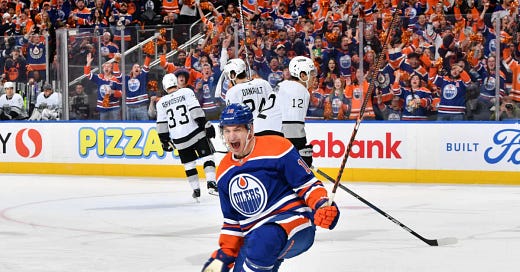By the Numbers - Which Notable NHL Forwards Are Underachieving & Overachieving to Start the 2024-25 Season
Which star forwards will pick up the pace as the season moves along, and which are expected to slump?
Nearly done with the first month of the season, there is a large enough sample to look at the NHL leaders in terms of points and take it with more than just a grain of salt. However, that doesn’t mean some players didn’t underachieve (or overachieve) in October. Which ones are destined to bounce back after a rough start? Conversely, which may have started off too well?
Defining On-Ice Shooting Percentage & Individual Points Percentage
To pinpoint some of the biggest underachievers and overachievers to this point, I’ll be using a couple of metrics. They are defined below:
On-ice shooting percentage (oiSH%) is a statistic that tracks how many goals and shots on goal a player is on the ice for, dividing the two for a final total (kind of like regular shooting percentage). Instead, it includes a player’s individual contributions plus those they share the ice with. Typically, star forwards vary from 10 to 15 percent (and usually on the higher end of that range) over a full season.
Individual points percentage (IPP) can be found by dividing a player’s total points by the amount of goals they’re on the ice for. Essentially, IPP tracks how involved a player is in their team’s offense. A good range is between 65 and 80 percent in an 82-game campaign, though not every star forward is the same.
With that out of the way, here are three players on both ends of the extreme:
Underachiever One: Steven Stamkos, Nashville Predators
Even after a two-point night versus his long-time team, the Tampa Bay Lightning, Steven Stamkos finds himself as one of hockey’s grandest underachievers to this point. Among forwards with at least 150 minutes of ice time (this is the criteria I’ll use for everyone), the 34-year-old has the third-worst oiSH% (5.19) and the 15th-lowest IPP (42.86).
This is a double-whammy of misfortune; shots aren’t going in when Stamkos is on the ice, and when they do, he’s not getting points on them. This has led to his underwhelming stat line of one goal and two assists through nine contests. What might he look like if we adjust his “bad luck”, so to speak?
Stamkos is a bit tricky since he relied quite a bit on Tampa Bay’s world-class power play and objectively better linemates, so we’ll go a bit conservative on the numbers here. If he had an oiSH% of 11.0 and an IPP of 65.0 (both below his previous three-year stats with the Lightning), Stamkos would have approximately 10 points this season.
Keep reading with a 7-day free trial
Subscribe to The Hockey Writers - NHL News, Rumors & Opinion to keep reading this post and get 7 days of free access to the full post archives.


